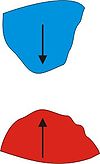
Fault friction
Encyclopedia
Fault friction describes the relation of friction
to fault mechanics
. Rock failure and associated earthquakes are very much a fractal
operation (see Characteristic earthquake). The process remains scale-invariant down to the smallest crystal
. Thus, the behaviour of massive earthquakes is dependent on the properties of single molecular irregularities or asperities.
 If we take two clean nano-asperities and bring them together in a vacuum
If we take two clean nano-asperities and bring them together in a vacuum
, we will get a cold weld. That is, the crystal tips will fuse as if one (cohesion
). In nature these tips are actually covered with a thin film of foreign material. By far, the most important component of this film, is water
.
 If this water is removed, by extreme drying, the rock minerals do not behave at all as expected: they exhibit no fault healing or dynamic friction. The entire behaviour of earthquakes (as we know it) depends on very thin films.
If this water is removed, by extreme drying, the rock minerals do not behave at all as expected: they exhibit no fault healing or dynamic friction. The entire behaviour of earthquakes (as we know it) depends on very thin films.
After a major earthquake, there starts a process known as fault healing. This is a well-demonstrated phenomenon involving a slow increase in the static coefficient of friction. With our nano-model, it is a matter of slowly pushing away the junk for a good cohesive bond. With typical minerals and water, there is another mechanism, whereby the water causes stress corrosion and weakening of the main asperity body (smoothing the irregularities), allowing more plastic deformation, and more contact.
The most important aspect is that this bond-strengthening is time-dependent. For a fault being stressed to the point of an earthquake, these bonds begin to stretch and break. They don’t have time to heal again. Once the critical distance has been achieved , there is a significant strength loss, and the fault begins to slide.
Earthquakes only exist because there is a very large loss in frictional strength. It could be that the earthquake "skids" are greased by silica gel, the water acts as a standard bearing lubricant, or that there is a "lift and separate" mechanism at work.
Friction
Friction is the force resisting the relative motion of solid surfaces, fluid layers, and/or material elements sliding against each other. There are several types of friction:...
to fault mechanics
Fault mechanics
Fault mechanics is a field of study that investigates the behavior of geologic faults.Behind every good earthquake is some weak rock. Whether the rock remains weak becomes an important point in determining the potential for bigger earthquakes....
. Rock failure and associated earthquakes are very much a fractal
Fractal
A fractal has been defined as "a rough or fragmented geometric shape that can be split into parts, each of which is a reduced-size copy of the whole," a property called self-similarity...
operation (see Characteristic earthquake). The process remains scale-invariant down to the smallest crystal
Crystal
A crystal or crystalline solid is a solid material whose constituent atoms, molecules, or ions are arranged in an orderly repeating pattern extending in all three spatial dimensions. The scientific study of crystals and crystal formation is known as crystallography...
. Thus, the behaviour of massive earthquakes is dependent on the properties of single molecular irregularities or asperities.

Vacuum
In everyday usage, vacuum is a volume of space that is essentially empty of matter, such that its gaseous pressure is much less than atmospheric pressure. The word comes from the Latin term for "empty". A perfect vacuum would be one with no particles in it at all, which is impossible to achieve in...
, we will get a cold weld. That is, the crystal tips will fuse as if one (cohesion
Cohesion (chemistry)
Cohesion or cohesive attraction or cohesive force is the action or property of like molecules sticking together, being mutually attractive...
). In nature these tips are actually covered with a thin film of foreign material. By far, the most important component of this film, is water
Water
Water is a chemical substance with the chemical formula H2O. A water molecule contains one oxygen and two hydrogen atoms connected by covalent bonds. Water is a liquid at ambient conditions, but it often co-exists on Earth with its solid state, ice, and gaseous state . Water also exists in a...
.

After a major earthquake, there starts a process known as fault healing. This is a well-demonstrated phenomenon involving a slow increase in the static coefficient of friction. With our nano-model, it is a matter of slowly pushing away the junk for a good cohesive bond. With typical minerals and water, there is another mechanism, whereby the water causes stress corrosion and weakening of the main asperity body (smoothing the irregularities), allowing more plastic deformation, and more contact.
The most important aspect is that this bond-strengthening is time-dependent. For a fault being stressed to the point of an earthquake, these bonds begin to stretch and break. They don’t have time to heal again. Once the critical distance has been achieved , there is a significant strength loss, and the fault begins to slide.
Earthquakes only exist because there is a very large loss in frictional strength. It could be that the earthquake "skids" are greased by silica gel, the water acts as a standard bearing lubricant, or that there is a "lift and separate" mechanism at work.

